
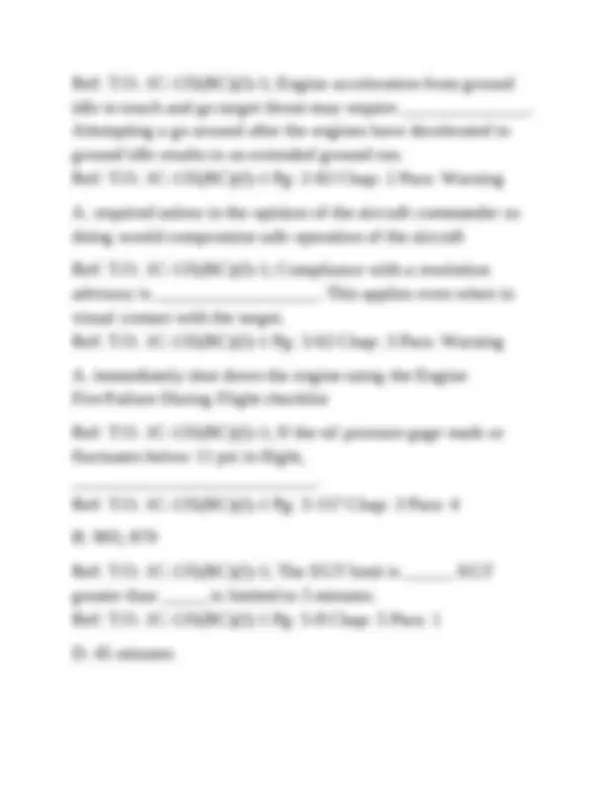
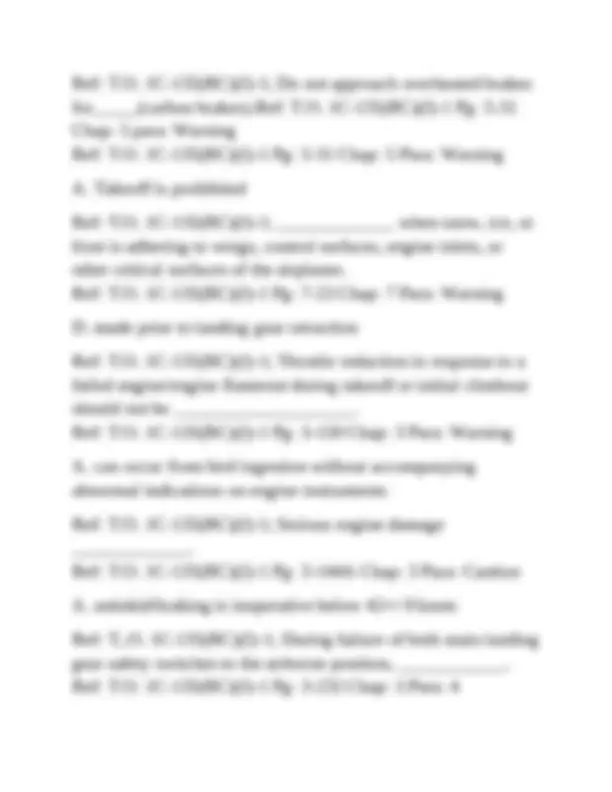
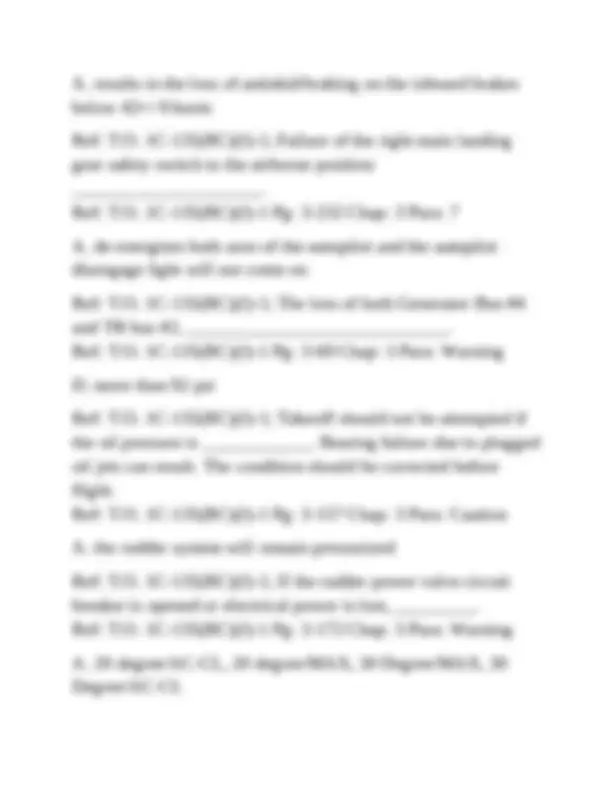
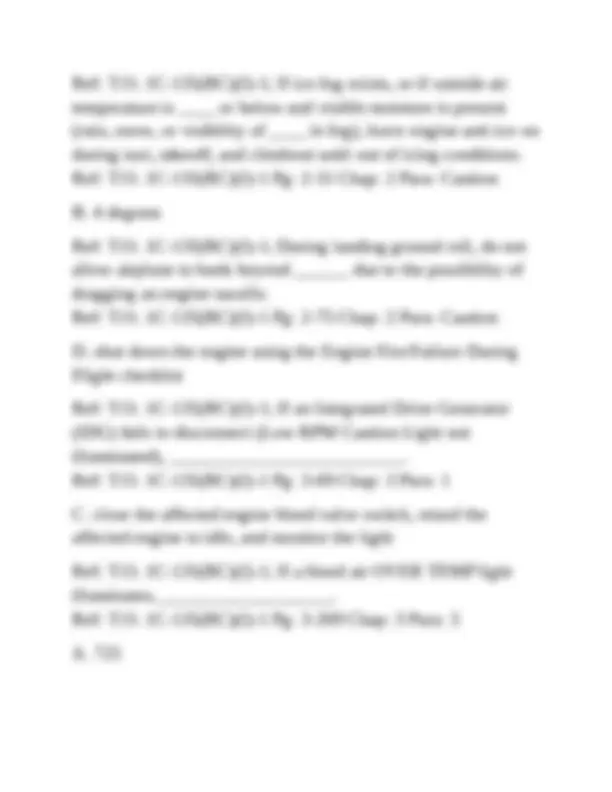
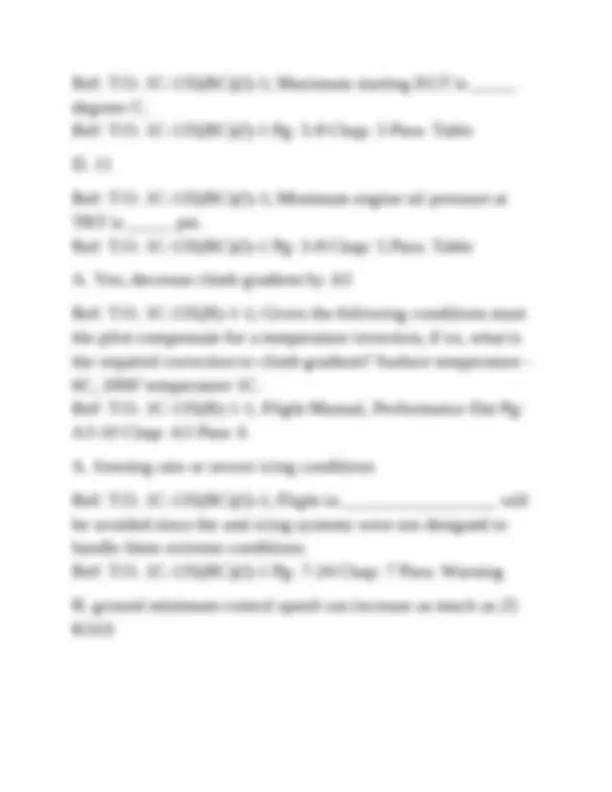
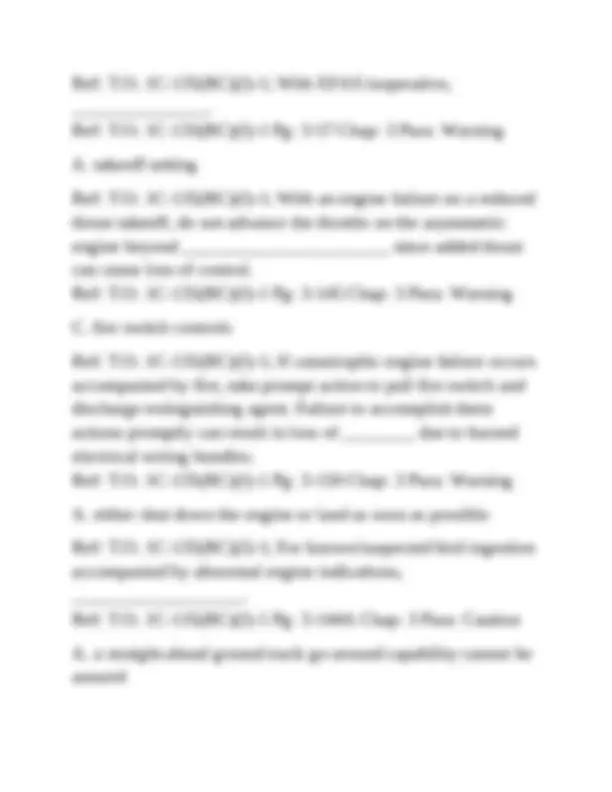
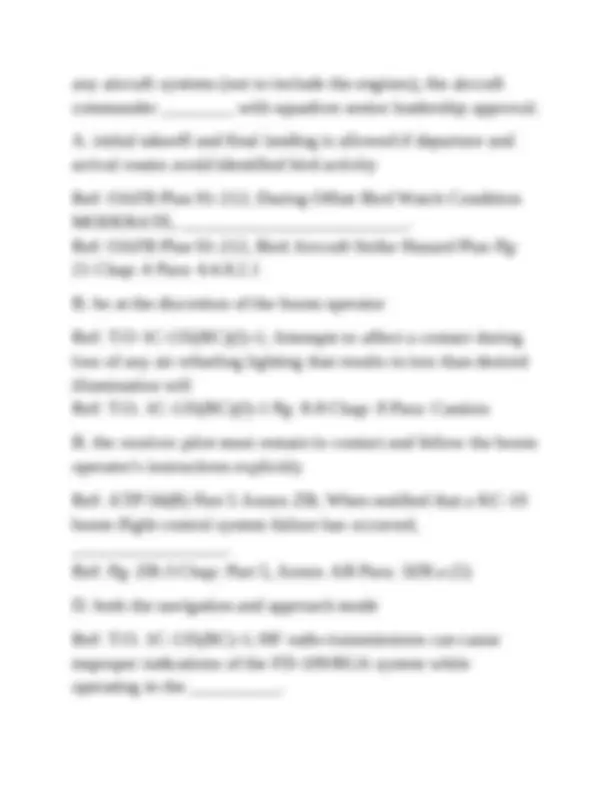
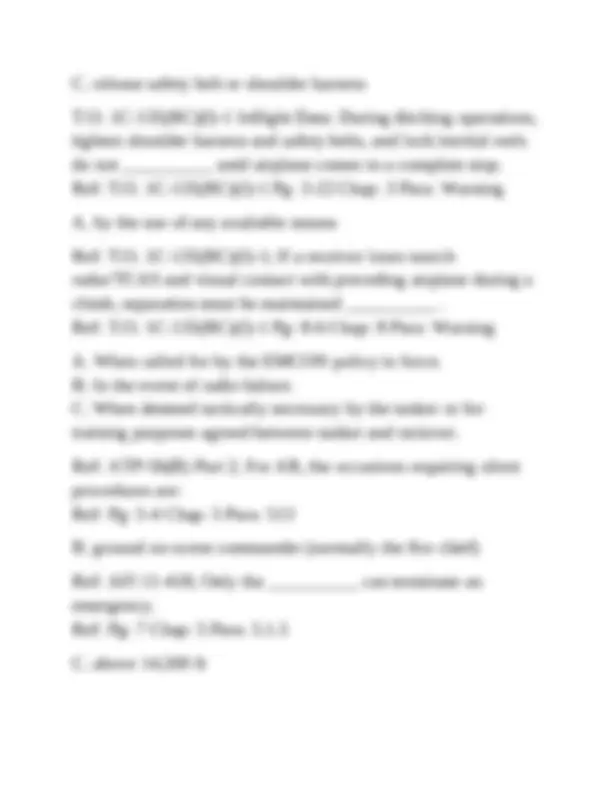
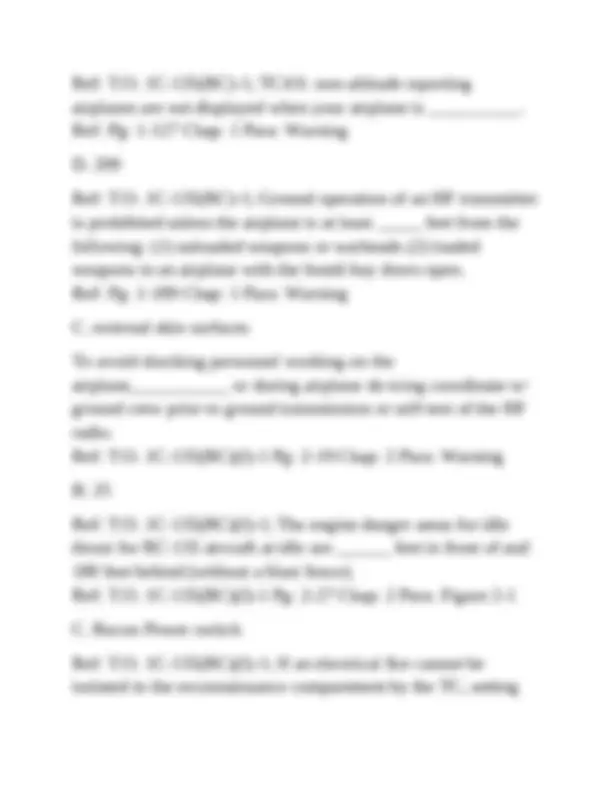
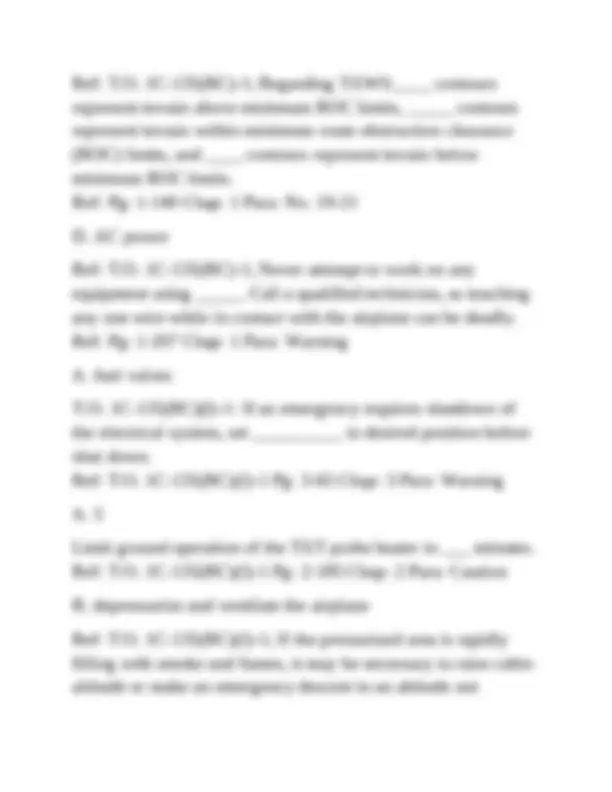
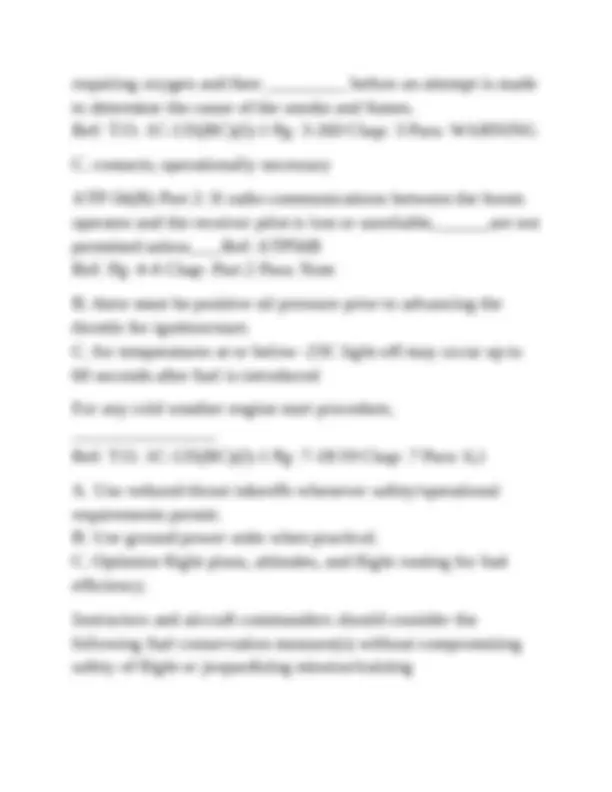



Study with the several resources on Docsity

Earn points by helping other students or get them with a premium plan


Prepare for your exams
Study with the several resources on Docsity

Earn points to download
Earn points by helping other students or get them with a premium plan
Community
Ask the community for help and clear up your study doubts
Discover the best universities in your country according to Docsity users
Free resources
Download our free guides on studying techniques, anxiety management strategies, and thesis advice from Docsity tutors
A collection of questions and answers related to aircraft operation, focusing on various aspects of flight procedures, engine management, and safety protocols. It provides insights into critical procedures, such as engine start, takeoff, landing, and emergency situations, offering valuable information for understanding aircraft operation.
Typology: Exams
1 / 20

This page cannot be seen from the preview
Don't miss anything!













Master Question File Questions With Complete Solutions A. 680 Ref: T.O. 1C-135(RC)(I)-1; If fuel flow exceeds _________ pph before lightoff, a hot start can occur. Be prepared to abort the start if a rapid EGT rise occurs, approaching starting limits. Ref: T.O. 1C-135(RC)(I)-1 Pg: 2-24 Chap: 2 Para: Caution C. 10 seconds Ref: T.O. 1C-135(RC)(I)-1; During a JFS engine start, if the JFS air inlet door or the JFS ready light does not illuminate within ____ after placing the starter switch to start, move starter switch to off. Ref: T.O. 1C-135(RC)(I)-1 Pg: 2-25 Chap: 2 Para: Caution B. 10 degrees C (50 degrees F) Ref: T.O. 1C-135(RC)(I)-1; During the Starting Engine and Before Taxi Check, if runway temperature is at or below ____ and standing water is visible on the ramp or taxiways, turn on engine anti-ice. Ref: T.O. 1C-135(RC)(I)-1 Pg: 2-31 Chap: 2 Para: Caution B. will be made within 5 minutes of takeoff to determine if the surfaces are still free of ice; ¼ inch of clear ice on the wings Ref: T.O. 1C-135(RC)(I)-1; When snow or ice is continually accumulating, a final physical check of the flight surfaces
__________. This check should be accomplished either by an exterior inspection or from the overwing hatches. From the control cabin, it is difficult to see coatings of as much as _________. Ref: T.O. 1C-135(RC)(I)-1 Pg: 2-42 Chap: 2 Para: Warning D. 10, 1 knot above 10 knots Ref: T.O. 1C-135(RC)(I)-1; For gust increments greater than______knots, add 1 knot for each_____to the APC- computed (no gust) rotation speed.Ref: T.O. 1C-135(RC)(I)- Pg 2-40, Note Ref: T.O. 1C-135(RC)(I)-1 Pg: 2-40 Chap: 2 Para: Note D. continue to follow the command bars; climb at recommended three-engine climbout speed Ref: T.O. 1C-135(RC)(I)-1; If an engine failure occurs during climbout ______________. With inoperative command bars, if an engine failure occurs during or immediately after takeoff, __________________. C. 8 degrees Ref: T.O. 1C-135(RC)(I)-1; Do not allow the bank angle at touchdown (4 to 6 degrees pitch attitudes) to exceed _________ due to the possibility of dragging and outboard engine nacelle. Ref: T.O. 1C-135(RC)(I)-1 Pg: 2-75 Chap: 2 Para: Caution A. up to 20 seconds
Ref: T.O. 1C-135(RC)(I)-1; Do not approach overheated brakes for_____(carbon brakes).Ref: T.O. 1C-135(RC)(I)-1 Pg: 5- Chap: 5 para: Warning Ref: T.O. 1C-135(RC)(I)-1 Pg: 5-31 Chap: 5 Para: Warning A. Takeoff is prohibited Ref: T.O. 1C-135(RC)(I)-1; _____________ when snow, ice, or frost is adhering to wings, control surfaces, engine inlets, or other critical surfaces of the airplanes. Ref: T.O. 1C-135(RC)(I)-1 Pg: 7-23 Chap: 7 Para: Warning D. made prior to landing gear retraction Ref: T.O. 1C-135(RC)(I)-1; Throttle reduction in response to a failed engine/engine flameout during takeoff or initial climbout should not be ____________________. Ref: T.O. 1C-135(RC)(I)-1 Pg: 3-150 Chap: 3 Para: Warning A. can occur from bird ingestion without accompanying abnormal indications on engine instruments Ref: T.O. 1C-135(RC)(I)-1; Serious engine damage _____________. Ref: T.O. 1C-135(RC)(I)-1 Pg: 3-144A Chap: 3 Para: Caution A. antiskid/braking is inoperative below 42+/-9 knots Ref: T,.O. 1C-135(RC)(I)-1; During failure of both main landing gear safety switches to the airborne position, ____________. Ref: T.O. 1C-135(RC)(I)-1 Pg: 3-232 Chap: 3 Para: 4
A. results in the loss of antiskid/braking on the inboard brakes below 42+/-9 knots Ref: T.O. 1C-135(RC)(I)-1; Failure of the right main landing gear safety switch to the airborne position _____________________. Ref: T.O. 1C-135(RC)(I)-1 Pg: 3-232 Chap: 3 Para: 7 A. de-energizes both axes of the autopilot and the autopilot disengage light will not come on Ref: T.O. 1C-135(RC)(I)-1; The loss of both Generator Bus # and TR bus #2, _____________________________. Ref: T.O. 1C-135(RC)(I)-1 Pg: 3-69 Chap: 3 Para: Warning D. more than 92 psi Ref: T.O. 1C-135(RC)(I)-1; Takeoff should not be attempted if the oil pressure is ____________. Bearing failure due to plugged oil jets can result. The condition should be corrected before flight. Ref: T.O. 1C-135(RC)(I)-1 Pg: 3-157 Chap: 3 Para: Caution A. the rudder system will remain pressurized Ref: T.O. 1C-135(RC)(I)-1; If the rudder power valve circuit breaker is opened or electrical power is lost, _________. Ref: T.O. 1C-135(RC)(I)-1 Pg: 3-172 Chap: 3 Para: Warning A. 20 degree/AC-CL, 20 degree/MAX, 30 Degree/MAX, 30 Degree/AC-CL
Ref: OAFB Plan 91-212; Anytime the Offutt BWC is SEVERE, ______________________. Ref: OAFB Plan 91-212, Bird Aircraft Strike Hazard Plan Pg: 10 Chap: 2 Para: 2.3.5.8. A. 63% Ref: T.O. 1C-135(RC)(I)-1; Damage to the starter can occur if N2 rpm exceeds ____ with the starter valve open light on. Ref: T.O. 1C-135(RC)(I)-1 Pg: 2-25 Chap: 2 Para: Caution C. abort the start to prevent the engine from exceeding EGT limits Ref: T.O. 1C-135(RC)(I)-1; If, during an engine start, N2 rpm rollback occurs prior to idle stabilization ______________________. Ref: T.O. 1C-135(RC)(I)-1 Pg: 2-26 Chap: 2 Para: Caution set the throttle to cutoff and continue to motor the engine for 60 seconds (re-engage pneumatic starter when N2 rpm drops below 25%) to clear unburned fuel Ref: T.O. 1C-135(RC)(I)-1; If a hot start, hung start, or no oil pressure condition occurs, ________________________________. Ref: T.O. 1C-135(RC)(I)-1 Pg: 2-30 Chap: 2 Para: Caution B. 10 degrees C (50 degrees F); 1 mile or less
Ref: T.O. 1C-135(RC)(I)-1; If ice fog exists, or if outside air temperature is ____ or below and visible moisture is present (rain, snow, or visibility of ____ in fog), leave engine anti-ice on during taxi, takeoff, and climbout until out of icing conditions. Ref: T.O. 1C-135(RC)(I)-1 Pg: 2-31 Chap: 2 Para: Caution B. 4 degrees Ref: T.O. 1C-135(RC)(I)-1; During landing ground roll, do not allow airplane to bank beyond ______ due to the possibility of dragging an engine nacelle. Ref: T.O. 1C-135(RC)(I)-1 Pg: 2-75 Chap: 2 Para: Caution D. shut down the engine using the Engine Fire/Failure During Flight checklist Ref: T.O. 1C-135(RC)(I)-1; If an Integrated Drive Generator (IDG) fails to disconnect (Low RPM Caution Light not illuminated), __________________________. Ref: T.O. 1C-135(RC)(I)-1 Pg: 3-69 Chap: 3 Para: 1 C. close the affected engine bleed valve switch, retard the affected engine to idle, and monitor the light Ref: T.O. 1C-135(RC)(I)-1; If a bleed air OVER TEMP light illuminates, ___________________. Ref: T.O. 1C-135(RC)(I)-1 Pg: 3-269 Chap: 3 Para: 3 A. 725
Ref: T.O. 1C-135(RC)(I)-1; With EFAS inoperative, _______________. Ref: T.O. 1C-135(RC)(I)-1 Pg: 3-57 Chap: 3 Para: Warning A. takeoff setting Ref: T.O. 1C-135(RC)(I)-1; With an engine failure on a reduced thrust takeoff, do not advance the throttle on the asymmetric engine beyond _______________________ since added thrust can cause loss of control. Ref: T.O. 1C-135(RC)(I)-1 Pg: 3-145 Chap: 3 Para: Warning C. fire switch controls Ref: T.O. 1C-135(RC)(I)-1; If catastrophic engine failure occurs accompanied by fire, take prompt action to pull fire switch and discharge extinguishing agent. Failure to accomplish these actions promptly can result in loss of ________ due to burned electrical wiring bundles. Ref: T.O. 1C-135(RC)(I)-1 Pg: 3-150 Chap: 3 Para: Warning A. either shut down the engine or land as soon as possible Ref: T.O. 1C-135(RC)(I)-1; For known/suspected bird ingestion accompanied by abnormal engine indications, ___________________. Ref: T.O. 1C-135(RC)(I)-1 Pg: 3-144A Chap: 3 Para: Caution A. a straight-ahead ground track go-around capability cannot be assured
Ref: T.O. 1C-135(RC)(I)-1; When landing with two engines inoperative on the same side (rudder power operative or inoperative), once airspeed is reduced below approach speed,
Ref: T.O. 1C-135(RC)(I)-1 Pg: 3-155 Chap: 3 Para: Warning A. the engines will remain in flight idle B. the pilot's brakes will not operate normally C. the rudder pedal nosewheel steering will be inoperative Ref: T.O. 1C-135(RC)(I)-1; If both main landing gear safety switches fail to the airborne position, _________________________. Ref: T.O. 1C-135(RC)(I)-1 Pg: 3-248 Chap: 3 Para: Table C. results in the loss of rudder pedal nosewheel steering Ref: T.O. 1C-135(RC)(I)-1; Failure of the left main landing gear safety switch to the airborne position _____________________ Ref: T.O. 1C-135(RC)(I)-1 Pg: 3-247 Chap: 3 Para: Table C. Vref+ What is minimum manuevering speed for flaps 20 degrees in traffic pattern. Ref: T.O. 1C-135(R)-1-1, Flight Manual, Performance Dat Pg: A9-6 Chap: A9 Para: Table B. 420
any aircraft systems (not to include the engines), the aircraft commander ________ with squadron senior leadership approval. A. initial takeoff and final landing is allowed if departure and arrival routes avoid identified bird activity Ref: OAFB Plan 91-212; During Offutt Bird Watch Condition MODERATE, _________________________. Ref: OAFB Plan 91-212, Bird Aircraft Strike Hazard Plan Pg: 21 Chap: 4 Para: 4.4.8.2. B. be at the discretion of the boom operator Ref: T.O 1C-135(RC)(I)-1; Attempts to affect a contact during loss of any air refueling lighting that results in less than desired illumination will Ref: T.O. 1C-135(RC)(I)-1 Pg: 8-8 Chap: 8 Para: Caution B. the receiver pilot must remain in contact and follow the boom operator's instructions explicitly Ref: ATP-56(B) Part 5 Annex ZB; When notified that a KC- boom flight control system failure has occurred, _________________. Ref: Pg: ZB-3 Chap: Part 5, Annex AB Para: 3ZB a (5) D. both the navigation and approach mode Ref: T.O. 1C-135(RC)-1; HF radio transmissions can cause improper indications of the FD-109/RGA system while operating in the __________.
C. release safety belt or shoulder harness T.O. 1C-135(RC)(I)-1 Inflight Data: During ditching operations, tighten shoulder harness and safety belts, and lock inertial reels do not __________ until airplane comes to a complete stop. Ref: T.O. 1C-135(RC)(I)-1 Pg: 3-22 Chap: 3 Para: Warning A. by the use of any available means Ref: T.O. 1C-135(RC)(I)-1; If a receiver loses search radar/TCAS and visual contact with preceding airplane during a climb, separation must be maintained __________. Ref: T.O. 1C-135(RC)(I)-1 Pg: 8-6 Chap: 8 Para: Warning A. When called for by the EMCON policy in force. B. In the event of radio failure. C. When deemed tactically necessary by the tanker or for training purposes agreed between tanker and reciever. Ref: ATP-56(B) Part 2; For AR, the occasions requiring silent procedures are: Ref: Pg: 5-4 Chap: 5 Para: 513 B. ground on-scene commander (normally the fire chief) Ref: AFI 11-418; Only the __________ can terminate an emergency. Ref: Pg: 7 Chap: 5 Para: 5.1. C. above 14,500 ft
_______ to OFF will remove power to most recon area equipment. Ref: T.O. 1C-135(RC)(I)-1 Pg: 3-65 Chap: 3 Para: Note C. made prior to landing gear retraction. Ref: T.O. 1C-135(RC)(I)-1; Throttle reduction in response to a failed engine/engine flameout during takeoff or initial climbout should not be Ref: T.O. 1C-135(RC)(I)-1 Pg: 3-150 Chap: 3 Para: Warning C. a positive generator disconnect is accomplished. Ref: T.O. 1C-135(RC)(I)-1; Do not attempt practice multiple full stop landings or touch and go landings with a known generator failure unless Ref: T.O. 1C-135(RC)(I)-1 Pg: 3-70 Chap: 3 Para: Caution B. the emergency renders the airplane incapable of flight. Ref: T.O. 1C-135(RC)(I)-1; Takeoff will not be aborted after S unless, in the opinion of the pilot, Ref: T.O. 1C-135(RC)(I)-1 Pg: 2-49 Chap: 2 Para: Warning C. do not operate stabilizer trim control switches Ref: T.O. 1C-135(RC)(I)-1; If fuel vapors are present in the cabin, _________. Ref: T.O. 1C-135(RC)(I)-1 Pg: 3-214 Chap: 3 Para: Note A. 10,
Ref: T.O. 1C-135(RC)(I)-1; For takeoff, approach, or landing; when fuel quantity in any main tank is less than ________ pounds, all tank to engine manifold valves will be opened and all boost pumps will be ON. Ref: T.O. 1C-135(RC)(I)-1 Pg: 2-43 Chap: 2 Para: Warning D. Speed brakes Ref: T.O. 1C-135(RC)(I)-1; __________ shall not be used at anytime below 1000 feet above field elevation during the final approach phase. Ref: T.O. 1C-135(RC)(I)-1 Pg: 2-65 Chap: 2 Para: Warning D. possible/NORMAL OXYGEN Ref: T.O. 1C-135(RC)-1; For some CRU-type regulators, it is _______ to breathe through the mask when the hose is disconnected or when dilutor lever is on ________ and the supply lever is off. Ref: Pg: 1-654 Chap: 1 Para: Warning A. 50 Ref: T.O. 1C-135(RC)-1; The oxygen pressure in the MA- portable oxygen bottle should not be permitted to drop below ____ psi. Ref: Pg: 1-653 Chap: 1 Para: Caution C. Red; Yellow; Green
requiring oxygen and then _________ before an attempt is made to determine the cause of the smoke and fumes. Ref: T.O. 1C-135(RC)(I)-1 Pg: 3-260 Chap: 3 Para: WARNING C. contacts; operationally necessary ATP-56(B) Part 2: If radio communications between the boom operator and the receiver pilot is lost or unreliable,______are not permitted unless___.Ref: ATP56B Ref: Pg: 4-4 Chap: Part 2 Para: Note B. there must be positive oil pressure prior to advancing the throttle for ignition/start. C. for temperatures at or below -23C light-off may occur up to 60 seconds after fuel is introduced For any cold weather engine start procedure,
Ref: T.O. 1C-135(RC)(I)-1 Pg: 7-18/19 Chap: 7 Para: 6, A. Use reduced-thrust takeoffs whenever safety/operational requirements permit. B. Use ground power units when practical. C. Optimize flight plans, altitudes, and flight routing for fuel efficiency. Instructors and aircraft commanders should consider the following fuel conservation measure(s) without compromising safety of flight or jeopardizing mission/training
accomplishment: Ref: AFI 11-2RC-135 V 3 Pg: 10 Chap: 6 Para: 6.3.1.